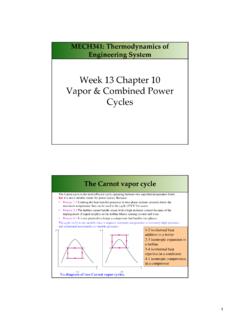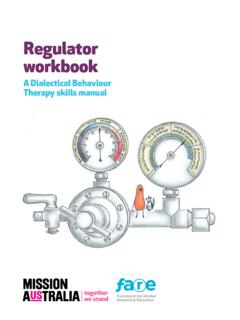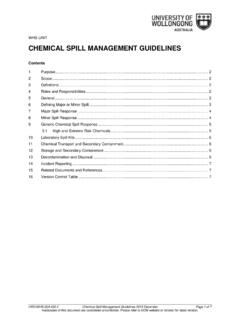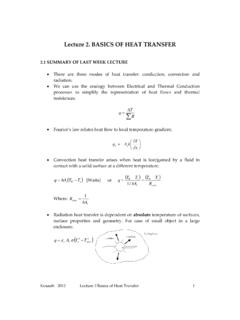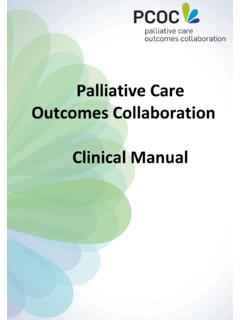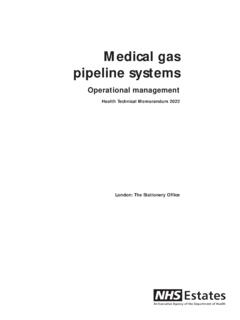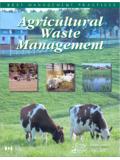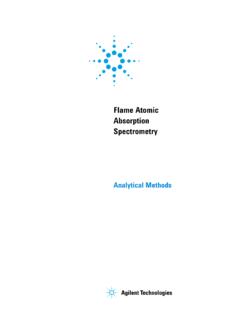Transcription of Storage and Handling of Gas Cylinders Guidelines
1 Storage and Handling of Gas Cylinders Guidelines 2015 December Page 1 of 14 Hardcopies of this document are considered uncontrolled. Please refer to UOW website or intranet for latest version. WHS UNIT Storage and Handling of Gas Cylinders Guidelines Contents 1 Background .. 2 2 Scope .. 2 3 Definitions .. 2 4 Types of Gases .. 2 5 Types of Gas Cylinders .. 3 6 Classes of Gases .. 4 7 Identification and Labelling .. 4 8 Cylinder Valves and Regulators .. 5 Cylinder Valves .. 5 6 9 Risks and Hazards from Gas Cylinders .. 6 10 Hazard Management .. 7 Storing Cylinders .. 7 Bulk Cylinder Storage .. 7 Laboratory Specific Storage Requirements Cylinders in Use.
2 8 Segregate Incompatible Gases and Dangerous Goods .. 9 Heat and Ignition Sources .. 9 Safe Handling Practices .. 10 Using Gas Cylinders .. 11 Manifest of Hazardous Chemicals .. 11 11 Transporting Gas Cylinders .. 11 Transport within Buildings .. 11 Transport with Vehicles .. 11 12 Troubleshooting .. 12 Cylinders in a Fire .. 12 Leaks .. 12 13 Cylinder Safety .. 13 14 Related Documents and References .. 14 15 Version Control Table .. 14 Storage and Handling of Gas Cylinders Guidelines Storage and Handling of Gas Cylinders Guidelines 2015 December Page 2 of 14 Hardcopies of this document are considered uncontrolled. Please refer to UOW website or intranet for latest version.
3 1 Background This document provides basic guidance on the safe Storage and Handling of compressed gas Cylinders . These Guidelines need to be followed in order to protect people, property and the environment from emergencies involving gas Cylinders as well as ensuring compliance with relevant legislation. 2 Scope These Guidelines apply to all workers and others who store and handle gas Cylinders at the University of Wollongong. 3 Definitions Asphyxiation Breathing difficulties (suffocation), loss of consciousness and eventual death caused by an inadequate supply of oxygen to the body. Flammable gas A gas that can be ignited in air.
4 Inert or Noble gas Any of the six gases helium, neon, argon, krypton, xenon, and radon. These gases are un-reactive except under certain special conditions. Non-flammable gas A gas that is neither flammable nor poisonous but can still cause asphyxia and death. Oxidizing gas A gas that initiates or promotes combustion of materials through release of oxygen. These gases can also spontaneously combust/explode. Short Term Exposure Limit (STEL) Maximum concentration of a gas that a person can be exposed to for a 15 minute period. Only 4 such exposure periods can occur within an 8 hour day and 1 hour break is required between exposure intervals.
5 Time Weighted Exposure Limit (TWA) Maximum concentration of a gas that a person can be exposed to for 8 hours per day over a 5 day working week. Toxic gas A gas that is poisonous or capable of causing injury or death, especially by chemical means. Upper and Lower Explosive Limits (UEL and LEL) Upper and lower concentration (in %) limits for which a particular gas is explosive in air. 4 Types of Gases There are three types of gases commonly supplied and used: 1. Compressed Gases Nitrogen, Oxygen, Air, Carbon Dioxide, Helium 2. Liquefied Gases LPG, Liquefied nitrous oxide 3. Dissolved Gases Acetylene Cryogenic vapour could also be considered as a gas but is dealt with in a separate document.
6 Refer to Storage , Transport and Handling of Cryogens Guidelines for information on vapour from cryogens. Storage and Handling of Gas Cylinders Guidelines Storage and Handling of Gas Cylinders Guidelines 2015 December Page 3 of 14 Hardcopies of this document are considered uncontrolled. Please refer to UOW website or intranet for latest version. 5 Types of Gas Cylinders In general, there are three types of gas Cylinders : 1. High Pressure Cylinders High pressure Cylinders come in a variety of sizes, see Figure 1. Some examples of gases supplied in High pressure Cylinders include Nitrogen, Helium, Hydrogen, Oxygen and Carbon Dioxide. 2. Low Pressure Cylinders Low pressure Cylinders come in a variety of sizes, see Figure 2.
7 Some examples of gases supplied in low pressure cylinder are LPG and refrigerant gases. 3. Acetylene Cylinders aggregate filled and acetylene is dissolved in acetone to get sufficient product into the cylinder. See Figure 3. Acetylene is in a class of its own as the cylinder is filled with an aggregate material and dissolved in a liquid medium (acetone). Figure 1: Size range of high pressure gas Cylinders available Figure 2 Size Range of low pressure gas Cylinders available Figure 3 Size Range of Acetylene Cylinders Available Storage and Handling of Gas Cylinders Guidelines Storage and Handling of Gas Cylinders Guidelines 2015 December Page 4 of 14 Hardcopies of this document are considered uncontrolled.
8 Please refer to UOW website or intranet for latest version. 6 Classes of Gases The following table shows the four main classes of gases. Gases can also have corrosive properties, eg Ammonia. The class of gas defines its physical properties and transport requirements. However, it is also important for considering Storage and Handling /usage requirements. 7 Identification and Labelling Gas Cylinders are required to be labelled with the following: Class label and any subsidiary risk labels The proper shipping name A four digit United Nations number Manufacturer/importer s name Cylinder sizes are denoted by a letter code.
9 The gas content of Cylinders is measured in cubic metres, litres or kilograms. If volume unit is given, it refers to standard temperature and pressure of 15 C ( kPa). Figure 4 Typical Gas Cylinder Label Information Dangerous Goods Diamond Class Examples Class Flammable gas LPG, hydrogen, acetylene Class Non-flammable, non-toxic gases Compressed air, nitrogen, argon, carbon dioxide, helium. Class , Sub-risk Oxidizing gas Oxygen, nitrous oxide , Entonox (50% oxygen, 50% nitrous oxide ). Class Toxic Gas Methyl bromide, anhydrous ammonia, chlorine. Storage and Handling of Gas Cylinders Guidelines Storage and Handling of Gas Cylinders Guidelines 2015 December Page 5 of 14 Hardcopies of this document are considered uncontrolled.
10 Please refer to UOW website or intranet for latest version. Protect the markings on Cylinders that identify the contents, and mark the full/empty status on Cylinders . Manufacturers paint gas Cylinders using a colour coded system that is useful for identification. You should consult the manufacturer s product catalogues for colour charts with this information. NEVER alter markings, labelling or colour coding of gas Cylinders supplied. They are a rented item and should be treated as such. The integrity and compliance of the gas cylinder is the supplier s responsibility. NOTE: All gas Cylinders are also fitted with a barcode by the supplier for tracking purposes.

